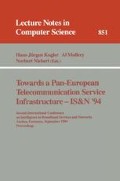Abstract
There is still clearly widespread resistance to the deployment of formal methods in industry. On the other hand, certain fields of application, viz. VLSI design, protocol specification, and certain kinds of system, viz. safety-critical, real-time, have of necessity already deployed some form of well-defined engineering methods to ensure a high degree of robustness and reliability in delivered products. In the telecommunications field there is currently a sense of the inevitable in the absolute necessity for the ultimate deployment of formal methods for service specification.
In this paper we begin by establishing our universe of discourse in order to de-mystify the term ‘formal methods’. Then, recognising the real need to justify yet again the use of ‘formal methods’ in industry, we set forth those principles by which management may be guided. Finally, we indicate exactly in what manner ‘formal methods’ may be embedded within a system development process model.
For definiteness, our arguments are presented within the context of multimedia service specification, in which context we take the liberty to announce some new results.
The results reported in this paper have arisen from work partially funded by the RACE Project Ref: 2017, Service Creation in an Object-oriented Reuse Environment (SCORE). The opinions expressed are those of the authors.
Preview
Unable to display preview. Download preview PDF.
References
00-55 (PART 1)/Issue 1, The Procurement of Safety Critical Software in Defence Equipment, PART 1: Requirements. Ministry of Defence, Interim Defence Standard, UK, 1991.
00-55 (PART 2)/Issue 1, The Procurement of Safety Critical Software in Defence Equipment, PART 2: Guidance. Ministry of Defence, Interim Defence Standard, UK, 1991.
Dines Bjørner and Cliff B. Jones, editors. The Vienna Development Method: The Meta-Language, Lecture Notes in Computer Science 61. Springer-Verlag, Berlin, 1978.
Michael Atiyah et al. Responses to ‘Theoretical Mathematics': Toward Cultural Synthesis of Mathematics and Theoretical Physics, by A. Jaffe and F. Quinn. Bulletin (New Series) of the American Mathematical Society, 30(2):178–207, April 1994.
Jonathan Bowen and Victoria Stavridou. The Industrial Take-up of Formal Methods in Safety-Critical and Other Areas: A Perspective. In J. C. P. Woodcock and P. G. Larsen, editors, FME'93: Industrial-Strength Formal Methods, Lecture Notes in Computer Science 670, pages 183–95. Springer-Verlag, Berlin, 1993.
Jean Dieudonné. Mathematics—the Music of Reason. Springer-Verlag, Berlin, 1992. H. G. and J. C. Dales (trans.), from the French Pour l'honneur de l'esprit humain, Hachette, Paris, 1987.
Nancy D. Griffeth and Yow-Jian Lin. Extending Telecommunications Systems: The Feature Interaction Problem, Guest Editors' Introduction. IEEE Computer, 26(8):14–18, August 1993.
Arthur Jaffe and Frank Quinn. 'Theoretical Mathematics': Toward Cultural Synthesis of Mathematics and Theoretical Physics. Bulletin (New Series) of the American Mathematical Society, 29(1):1–13, July 1993.
Haim Kilov and James M. Ross, III. Information Modeling: An Object-Oriented Approach. Prentice Hall, Englewood Cliffs, New Jersey, 1993.
Mícheál Mac an Airchinnigh. Ph.D. Thesis: Conceptual Models and Computing. Department of Computer Science, University of Dublin, Trinity College, Dublin, Ireland, 1990.
Mícheál Mac an Airchinnigh. Tutorial Lecture Notes on the Irish School of the VDM. In S. Prehn and W. J. Toetenel, editors, VDM'91, Formal Software Development Methods Volume 2: Tutorials, Lecture Notes in Computer Science 552, pages 141–237. Springer-Verlag, Berlin, 1991.
Mícheál Mac an Airchinnigh. Formal Methods & Testing. In Tutorials of the Sixth International Software Quality Week, 625 Third Street, San Francisco, CA 94107-1997, May 1993. Software Research Institute.
Norman Potter. What is a designer: things, places, messages. Hyphen Press, London, revised third edition, [1969], 1989.
Jacques Printz. Mathematical training for the software developers: a practical experience. Bulletin of the European Association for Theoretical Computer Science, (52):336–373, February 1994.
Margaret Tierney. Software Engineering Standards: the ‘Formal Methods Debate’ in the UK. Technology Analysis & Strategic Management, 4(3):245–78, 1992.
Jeffrey J. P. Tsai, Thomas Weigert, and Hung-Chin Jang. A Hybrid Representation as a Basis of Requirement Specification and Specification Analysis. IEEE Transactions on Software Engineering, 18(12):1076–100, December 1992.
Debora Weber-Wulff. Selling Formal Methods to Industry. In J. C. P. Woodcock and P. G. Larsen, editors, FME'93: Industrial-Strength Formal Methods, Lecture Notes in Computer Science 670, pages 671–8. Springer-Verlag, Berlin, 1993.
Pamela Zave. Feature Interactions and Formal Specifications in Telecommunications. IEEE Computer, 26(8):20–30, August 1993.
Pamela Zave and Michael Jackson. Techniques for Partial Specification and Specification of Switching Systems. In S. Prehn and W. J. Toetenel, editors, VDM'91, Formal Software Development Methods Volume 1: Conference Contributions, Lecture Notes in Computer Science 552, pages 511–25. Springer-Verlag, Berlin, 1991.
Author information
Authors and Affiliations
Editor information
Rights and permissions
Copyright information
© 1994 Springer-Verlag Berlin Heidelberg
About this paper
Cite this paper
Airchinnigh, M.M.a., Belsnes, D., O'Regan, G. (1994). Formal methods & service specification. In: Kugler, HJ., Mullery, A., Niebert, N. (eds) Towards a Pan-European Telecommunication Service Infrastructure — IS&N '94. IS&N 1994. Lecture Notes in Computer Science, vol 851. Springer, Berlin, Heidelberg. https://doi.org/10.1007/BFb0013448
Download citation
DOI: https://doi.org/10.1007/BFb0013448
Published:
Publisher Name: Springer, Berlin, Heidelberg
Print ISBN: 978-3-540-58420-9
Online ISBN: 978-3-540-48784-5
eBook Packages: Springer Book Archive

